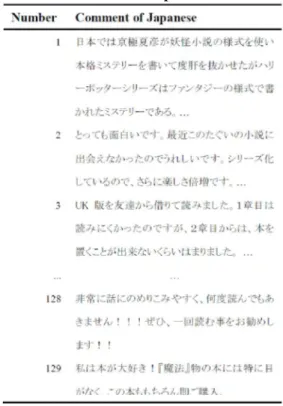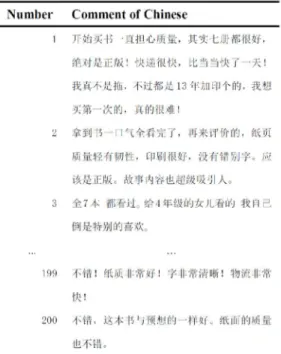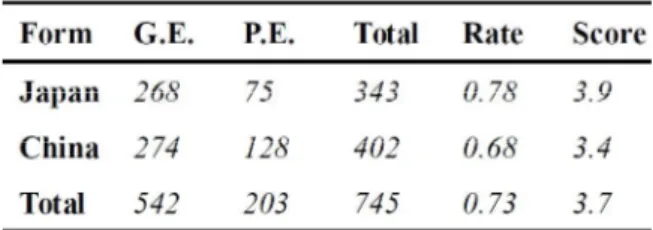International Journal of Management and Applied Science, ISSN: 2394-7926 Volume-2, Issue-3, Mar.-2016
A Study on the Review Analysis For the Automatic Evaluation of the Product 32
A STUDY ON THE REVIEW ANALYSIS FOR THE AUTOMATIC
EVALUATION OF THE PRODUCT
1
ZHUORAN SUN, 2MINORU YOSHIDA, 3KAZUYUKI MATSUMOTO, 4KENJI KITA
1,2,3,4
Faculty and School of Engineering, University of Tokushima, Tokushima, 7708506, Japan E-mail: 1c501437042@tokushima-u.ac.jp, 2mino@is.tokushima-u.ac.jp, 3matumoto@is.tokushima-u.ac.jp,
4
kita@is.tokushima-u.ac.jp
Abstract- Nowadays, e-business has been never more popular and more convenient. Online merchants have flourished and
merchandize have diversified. However, it’s still difficult for users to quickly locate their desired products on online markets. Often times, an online shopper will evaluate ratings and comments from other users to speculate the current product. In particular, the easiest and the most intuitive way is to see the scores to determine the quality of the product. Therefore, if we can automatically identify and analyze all the reviews and accurately and objectively give a score to a particular product, it will be more efficient for users to search merchandize and for online business owners to manage the products they sell.
Keywords- E-business, Reviews, Analysis, Automatic Evaluation, Manage
I. INTRODUCTION
Nowadays,online reviews for goods and services sold and provided on the online marketplace have shown a practical phenomenon of Big Data. For example, Amazon.co.jp*1of Japan, Taobao marketplace of China*2, Rakuten marketplace of Japan*3 all usea 1-5 ratingschemefor users to rate the products they purchased.To give another example, “GURUNAVI” *4allows user to post reviews on restaurants. From a statistical point of view, almost all websites use the aforementioned 1-5 rating scheme..Note that this rating scheme does not limit commentators, who may comment on the pros and cons of the provided goodsand services. Of course, positive reviews will most likely benefit them.
For consumers, looking at the ratings is the most straightforward way to make a purchase decision. However, research has shown that current rating mechanism on most website is based on consumers’ personal opinions. The problem is with this is that a user’s rating fails to align with the reviews. For example, the review with a 5-start rating doesn’t meet the 5-star standard. Another problem is the polarization of ratings where a user will either give a 5 or a 1. Users rarely usescores in the middle range or they claim that they don’t know how to apply the rating rubrics.
Therefore, I wonder if it is possible to rate a merchandize from analyzing user reviews and summarizing the number of favorable reviews. As a result, ratings will vary with the number of user reviews and will be more objective and practical.Also it can make a comprehensive judgment with commentswhich are written by people in different country on the same commodity such as books, movies, CDs, etc.
II. DETAILS EXPERIMENTAL
2.1. Data Collection
In this research, we have gathered database from the online shopping platform, Amazon for Japan and China. Specifically, we extracted two types of data, user evaluation data and user review data. Either type is extracted with 209 records (129 positive reviews and 80 negative reviews) for Japanese,and 382 records (200 positive reviews and 182 negative reviews) for Chinese which will be used as raw database for this experiment.But we collect more data for research.
But, in this paper, I will show a simple example about comparison between Japan and China, about the Harry Potter series of comments, and get a composite score for this book.
International Journal of Management and Applied Science, ISSN: 2394-7926 Volume-2, Issue-3, Mar.-2016
A Study on the Review Analysis For the Automatic Evaluation of the Product 33
Table 2Data base for Chinese comments
2.2. Data analysis
Inthis experiment, we use a phrase score SS(S) for string s defined as:
This score can be considered as the Bayesian a posterior probability of s being in corpus C after observing freq(s,C) and freq(s,C’).When extract good reviews, the freq(s,C) is for 5 score, and freq(s,C’) is for below 4 score. On the contrary, when extract poor reviews, the freq(s,C) is below4 score, and the freq(s,C’) is for 5 score.
The edge score of string s is defined by below.
Using this equation, we can get the most coherent meaning, and the most complete expression. So we use there score to sort the results. We put the number set to 1000 for results.
Table 3DataAnalysis for Good Expression of Japanese
Table 4 Data Analysis for Poor Expression of Japanese
Table 5 Data Analysis for Good Expression of Chinese
Table 6 Data Analysis for Poor Expression of Chinese
III. RESULTS AND DISCUSSION 3.1 Results Analysis
From the result of data analysis according chapter 2, we can see that we get a lot of phrases, some can distinguish whether good or poor expression keywords, but also have some irrelevant phrases. So we must get rid of noise. We put results in the second filter, remove noise, punctuation, emoticons, and so on irrelevant information. The secondary screening for the four results (praise and bad review of Japanese, praise and bad review of Chinese) as following tables.
International Journal of Management and Applied Science, ISSN: 2394-7926 Volume-2, Issue-3, Mar.-2016
A Study on the Review Analysis For the Automatic Evaluation of the Product 34
Table 7The Second Filter for Get Useful Good Expression of Japanese
Table 8The Second Filter for Get Useful Poor Expression of Japanese
Table 9The Second Filter for Get Useful Good Expression of Chinese
Table 10The Second Filter for Get Useful PoorExpression of Chinese
3.2 Comprehensive Score Calculation
Using the results of second filter, we can get the comprehensive score by follow equation.
means the total number of Good Expression, in the same way PEmeans the total number of Poor Expression. We want to get the composite score, so we need get the sum of the total number of good expression of Japanese and Chinese, in a similar way get the sum of the total number of poor expression of Japanese and Chinese. So we get the final score as following table.
Table 11The Comprehensive Score
There are many possible ways to rate items using the extracted results. Among this, we used the following score assuming that the smaller the number of noises in the extracted expressions is, the more coherent the set of reviews is.
CONCLUSIONS
For now users are free to write comments on the internet is increasingly popular, and the amount is also more and more hugeness. So the analysis for big data such as this is also more and more important and useful. However, natural language parsing is not particularly perfect so far.
For example, in this experiment, phrases in the database for feature extraction, sometimes the results are not very ideal. When dividing words sometimes is divided into a mess, cannot understand the meaning completely, or it can dismantle a complete word, lead to word meaning is not complete, or have polysemy. So it is hard to judge the word is good or poor.
REFERENCES
[1] The web site of Amazon.co.jp:
http://www.amazon.co.jp/
[2] The web site of Amazon.cn:
http://www.amazon.cn/
[3] The web site of Taobao:
http://www.taobao.com/
[4] The web site of Rakuten:
http://www.rakuten.co.jp/
[5] The web site of GURUNAVI:
International Journal of Management and Applied Science, ISSN: 2394-7926 Volume-2, Issue-3, Mar.-2016
A Study on the Review Analysis For the Automatic Evaluation of the Product 35
[6] Minoru Yoshida, Kazuyuki Matsumoto,
Qingmei Xiao, XielifuguliKeranmu, Kenji Kita, Hiroshi Nakagawa, “Extracting Corpus-Specific Strings by Using Suffix Arrays Enhanced with Longest Common Prefix”, Information Retrieval Technology, 10th Asia Information Retrieval Societies Conference, AIRS 2014, Kuching, Malaysia, pp.360-370, December 3-5, 2014
[7] Tsuyoshi Katasho, “Analysis of evaluation data on the Internet” Mejiro University, The Graduate School of Psychology
[8] Miyuki Yamasawa, Hiroki Yoshimura, Hiroshi
Masuichi, “Distinguishing usefulness among
Amazon’s review sentences” IPSJ SIG Technical Report 173, 15-20, 2006-05-19
[9] Yuki Uchida, Tomohiro Yoshikawa, Takeshi Furuhashi, EijiHirao, Hiroto Iguchi, “A Proposal of Text Mapping Method to Analyze Web User Reviews” 24th Fuzzy System Symposium, Osaka, September 3-5, 2008
[10] Bo Pang, Lillian Lee, “Seeing stars: Exploiting class relationships for sentiment categorization with respect to rating scales” ACL '05 Proceedings of the 43rd Annual Meeting on Association for Computational Linguistics, pp.115-124, Association for Computational Linguistics Stroudsburg, PA, USA ©2005


